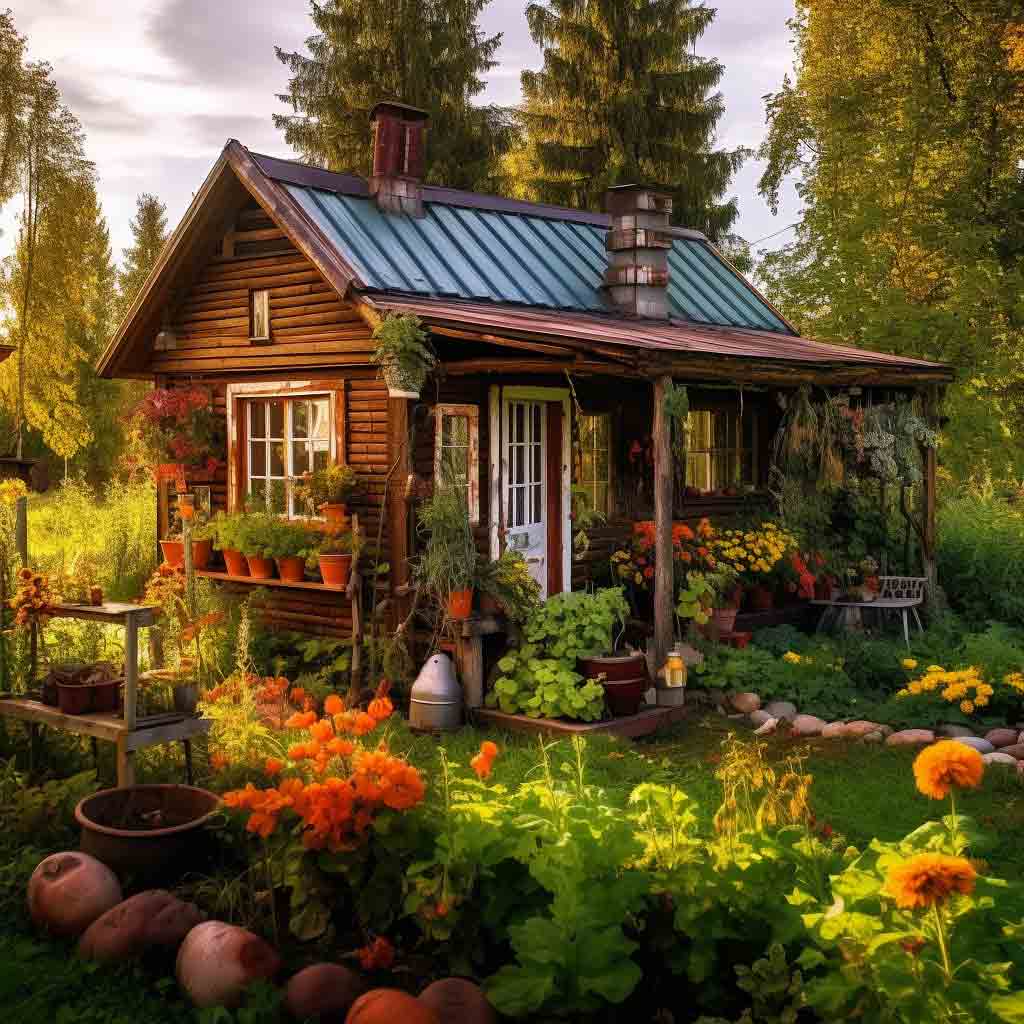How Much Land Do I Need To Live Off Grid?

How Much Land Do I Need To Live Off Grid?
This is how to determine how much land you need to live off grid and grow enough food to provide for a family of 4. 1-2 acres is enough to feed you and your family. But is it enough to live on? 3-5 acres is probably better because it gives you a certain amount of room to expand and be a bit more private and secluded.
NOTE: Finding that perfect parcel of land is also important, fortunately we have written multiple articles on how to find off grid land.
It depends on how your grow your food. The water and power are the easy parts compared to growing your own food. The food is the hard part.
Growing enough food for 4 people is going to take a lot of work and how you grow will dictate how much food you can produce on any given square foot of land. Traditional row-cropping takes up a lot of space versus vertical gardening for example. There's a family in California that grows 6000 pounds of fresh fruits and veggies on 1/10th an acre of land using all sorts of growing techniques to maximize yield per square foot. This isn't about how large a piece of land you need. This is about how efficiently you utilize the land you have with creative gardening techniques designed to maximize your annual food yield.
Living off the grid and embracing a self-sufficient lifestyle offers numerous benefits, from reducing environmental impact to fostering greater independence.
If you aspire to support your family of four sustainably, growing your own food, producing your own water and power, one crucial consideration is the amount of land required to meet these needs.
In this article, we will explore the factors to consider and provide guidelines for determining the ideal land size for your off-grid living endeavors.
Assessing Food Production Needs
To sustainably grow your own food, evaluate your dietary preferences, consumption patterns, and gardening techniques. On average, a family of four can thrive on 1-2 acres of land dedicated to vegetable gardens, fruit trees, herbs, and small livestock such as chickens or rabbits. Consider crop rotation, companion planting, and vertical gardening to optimize space usage and maximize yield.
Calculating Water Requirements
Evaluate the availability of water sources on your land and assess the feasibility of rainwater harvesting systems. Calculate your household's water needs for drinking, cooking, sanitation, and irrigation. Depending on the climate and rainfall patterns, you may require additional land for water catchment systems, storage tanks, and irrigation infrastructure.
Estimating Power Generation Capacity
To determine the land size needed for renewable energy systems, evaluate your energy consumption and consider the efficiency of the chosen technologies. Solar panels and wind turbines are common options for off-grid power generation. Consult with experts to calculate the appropriate capacity based on your energy needs. Consider factors like the availability of sunlight or wind resources on your land to optimize energy production.
Designing Living Space
Allocate space for your off-grid home, taking into account the size and layout needed to accommodate your family comfortably. Consider the number of rooms required, living areas, and any specific needs or preferences. Balancing functionality and sustainability, you can incorporate energy-efficient design principles and eco-friendly materials.
Outdoor Living and Expansion
Reserve outdoor space for recreational activities, gardening, and potential future expansions. Plan areas for relaxation, outdoor cooking, composting, and other outdoor living needs. This space allows you to connect with nature, promote biodiversity, and explore additional self-sufficiency projects.
Determining the ideal land size for sustainable off-grid living involves considering factors such as food production, water resources, renewable energy systems, and living space requirements. While a family of four can typically sustainably manage on 1-2 acres of land, it's essential to tailor your plans based on specific circumstances, climate, and goals. Conduct a thorough assessment of your needs, consult with experts, and embark on your off-grid journey with careful planning and a commitment to sustainable living. By embracing self-sufficiency, you can enjoy the rewards of a more eco-conscious and resilient lifestyle.
Maximizing Crop Yield with Sustainable Growing Techniques: A Guide to Aquaponics, Hydroponics, and Vertical Gardening
As the world faces the challenge of feeding a growing population while minimizing environmental impact, sustainable growing techniques have gained prominence. Aquaponics, hydroponics, and vertical gardening offer innovative solutions to increase crop yield and optimize space utilization. In this article, we will explore these techniques and their integration to create a sustainable and productive farming system.
Aquaponics
A Harmonious Ecosystem for Plant Growth and Fish Cultivation Aquaponics is a symbiotic system that combines aquaculture (fish farming) with hydroponics (soilless plant cultivation). The fish waste provides essential nutrients for the plants, while the plants naturally filter the water for the fish. This closed-loop system maximizes resource efficiency and minimizes waste. By incorporating aquaponics, you can significantly increase crop yield while cultivating healthy fish.
Key benefits of aquaponics include:
- Efficient nutrient cycling: Fish waste provides organic nutrients for plants, reducing the need for external fertilizers.
- Water conservation: Aquaponics uses up to 90% less water compared to traditional soil-based farming methods.
- Year-round cultivation: The controlled environment allows for year-round crop production, unaffected by weather conditions.
- Space optimization: Aquaponics systems can be vertically stacked, making efficient use of limited space in urban areas.
- Hydroponics: Soilless Cultivation for Enhanced Crop Growth Hydroponics involves growing plants in nutrient-rich water solutions, eliminating the need for soil. This technique provides precise control over nutrient levels, pH, and water delivery, allowing plants to grow faster and produce higher yields. By optimizing environmental conditions and nutrient availability, hydroponics can significantly increase crop productivity.
Advantages of hydroponics include:
- Faster growth and higher yields: Plants in hydroponic systems grow up to 50% faster than in traditional soil-based farming.
- Water and resource efficiency: Hydroponics uses 70-90% less water compared to conventional farming methods.
- Reduced disease and pest issues: The absence of soil minimizes the risk of soil-borne diseases and pests.
- Year-round production: Hydroponics enables year-round cultivation regardless of seasonal variations.
Vertical Gardening
Utilizing Vertical Space for Increased Crop Density Vertical gardening is a space-saving technique that involves growing plants vertically, utilizing walls, trellises, or stacked containers. This technique is particularly beneficial in urban environments or limited land spaces. By maximizing the use of vertical space, you can significantly increase crop density and overall productivity.
Advantages of vertical gardening include:
- Efficient space utilization: Vertical systems allow for a higher number of plants per square meter, increasing yield potential.
- Reduced soil erosion and water runoff: Vertical gardening minimizes soil erosion and water runoff, preserving valuable resources.
- Improved accessibility and maintenance: Vertical setups provide easier access for planting, maintenance, and harvesting.
- Aesthetic appeal and air purification: Vertical gardens enhance the visual appeal of urban spaces and improve air quality.
Integration and Synergy
Combining Aquaponics, Hydroponics, and Vertical Gardening By combining aquaponics, hydroponics, and vertical gardening, you can create a highly productive and sustainable farming system. Aquaponics provides nutrient-rich water for hydroponic systems, while vertical gardening optimizes space utilization and light exposure. This integrated approach maximizes crop yield, conserves resources, and minimizes environmental impact.
Incorporating sustainable growing techniques such as aquaponics, hydroponics, and vertical gardening is a powerful way to increase crop yield and contribute to a more sustainable food system.
These methods offer efficient resource utilization, year-round production, and the potential for high-density cultivation.
By embracing these techniques, farmers and gardeners can play a crucial role in feeding the world while minimizing their ecological footprint.
Year-Round Food Production: Harnessing Solar Power for Greenhouse Heating
Greenhouses offer an excellent opportunity to extend the growing season and cultivate fresh, nutritious food year-round. By incorporating an in-floor radiant heating system powered by solar energy, you can create a sustainable and efficient environment for plant growth even during colder months. In this article, we explore the benefits and considerations of utilizing solar power to heat a greenhouse and implementing an in-floor radiant heating system.
Harnessing Solar Power for Greenhouse Heating: Solar power provides a renewable and environmentally friendly energy source to heat your greenhouse. By installing solar panels, you can generate electricity to power the heating system, reducing reliance on conventional energy sources and lowering your carbon footprint. Solar energy is abundant, free, and accessible, making it an ideal choice for sustainable greenhouse operations.
In-Floor Radiant Heating System: An in-floor radiant heating system is a highly efficient method to distribute heat evenly throughout the greenhouse. It involves installing a network of water pipes beneath the greenhouse floor, which are heated to warm the space. The system operates silently, providing gentle and consistent heat to the plants and the surrounding environment.
Benefits of an in-floor radiant heating system:
- Energy efficiency: Radiant heating systems are known for their high energy efficiency, as they minimize heat loss and ensure efficient distribution.
- Uniform heat distribution: The radiant heat rises from the floor, ensuring consistent temperatures across the entire greenhouse.
- Plant health and growth: The gentle, radiant heat promotes optimal plant growth, root development, and photosynthesis, resulting in healthier and more productive plants.
- Reduced pest and disease risk: Maintaining a consistent temperature helps minimize the risk of pests and diseases that thrive in colder conditions.
- Comfortable working environment: The radiant heat creates a comfortable working environment for gardeners, allowing them to tend to plants without discomfort.
Solar-Powered Water Pump
To power the in-floor radiant heating system, a small solar-powered water pump can be utilized. This pump circulates the heated water through the pipes, ensuring efficient heat transfer to the greenhouse. The solar-powered water pump eliminates the need for grid electricity, making the system more self-sufficient and sustainable.
Benefits of a solar-powered water pump:
- Renewable energy source: Solar power eliminates the reliance on fossil fuels, providing a clean and renewable energy alternative.
- Cost-effective: Once installed, solar-powered water pumps have minimal operating costs, reducing long-term expenses.
- Easy installation: Solar-powered water pumps are relatively simple to install and maintain, requiring minimal wiring and infrastructure.
- Low environmental impact: Solar-powered systems have minimal environmental impact, producing zero emissions and reducing carbon footprint.
Building a greenhouse with an in-floor radiant heating system powered by solar energy enables year-round food production in a sustainable and environmentally friendly manner. The combination of solar power and radiant heating ensures efficient heat distribution, optimal plant growth, and reduced reliance on non-renewable energy sources. Embracing solar technology in greenhouse heating contributes to a greener future while supporting self-sufficiency and the availability of fresh, homegrown food throughout the year.





